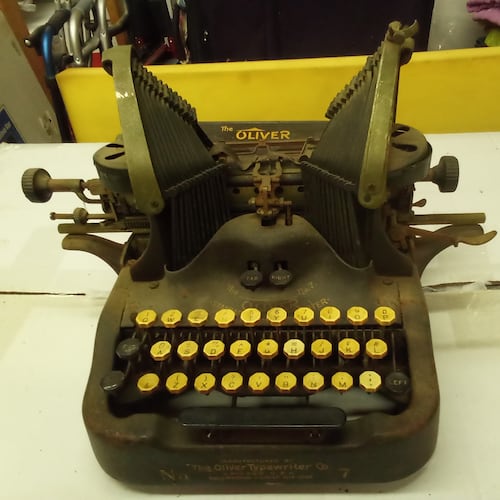When Margaret Robison was a student at the University of Georgia, she snapped a photo of her husband-to-be along a highway near Athens. In it, their elongated shadows stretch over the asphalt.
The photo, she says, became an apt metaphor for their future: a marriage shadowed by alcoholism, violence and madness. Their two sons grew up amid chaos. The younger one, under the pen name Augusten Burroughs, described his family life as appalling and absurd in his best-selling memoir “Running With Scissors” — making his mother infamous. The older, John Elder Robison, wrote “Look Me in the Eye,” a memoir of his life with Asperger’s syndrome.
Now Margaret Robison’s own memoir, “The Long Journey Home,” tells her side of the story.
Born in 1935, she grew up in the small town of Cairo, Ga. She was a precocious child who loved to write and draw. Her family had its share of eccentric members, but hers is no darkly humorous Southern Gothic tale.
She married a ministerial student, John Robison, whose family lived in an old white-columned house in a wooded area near Lawrenceville. John Robison had slapped her face during an argument when they were dating. His own alcoholic father frequently came home drunk and threatened his wife physically. On one occasion, he’d blasted holes in the bedroom ceiling with his shotgun.
Margaret Robison set aside her art studies and — with some hesitation — got married. John Robison switched to the study of philosophy, earned a Ph.D. and eventually joined the faculty at the University of Massachusetts in Amherst. Along the way, he had an affair.
When Margaret Robison considered divorcing him, he threatened suicide and spent a short time in a mental hospital. In the environment of a New England college town in the 1960s, their troubled marriage became worse, and both became mentally unglued. It was only natural that they would turn to psychiatrists.
Enter the Harvard-trained Rodolph Turcotte, unconventional by any standards. He urged many of his patients to live at the Town House Motor Lodge on Route 5 near Northampton. Other patients lived with him and his family in a large, run-down Victorian house. In addition to his wife, Ethel, he had sexual relationships with two other women he called his “wives.” Turcotte believed that young teenagers were practically adults and should have adult freedoms. Although Margaret Robison noticed some oddities, she said he was the first psychiatrist who took seriously her husband’s threats of violence toward her.
Turcotte followed a let-it-all-hang-out theory, believing that full expression of anger was the way to defuse it. Margaret Robison spent many hours in his office listening to her husband vent.
She writes that she grew more and more manic under this regimen. It was at this time that she experienced her first bout of madness.
She describes the experience of being psychotic, the shifting states of mind and the terror of being adrift. As her story proceeds, she doesn’t clearly delineate the times she was psychotic and the time she wasn’t. They flow into each other.
She doesn’t stand back and look at her illness. She never even tells us her diagnosis. In fact, the most absurd things are discussed in a bland style.
When her aunt cuts off financial support, Turcotte wants to drive down to Georgia to confront the aunt. Margaret Robison writes, “I agonized at the thought of Dr. Turcotte going to Cairo,” but the complete inappropriateness of his trip seems lost on her.
In an aside, she mentions that she had made Turcotte her son’s legal guardian so that Augusten could live with the doctor and “attend school in Northampton, rather than Amherst, where he felt suicidal.” This startling information is not elaborated upon. The reader is left to piece it all together.
The book reflects the problems of Robison’s life — a failure to recognize or acknowledge normal boundaries.
In her sons’ memoirs, vivid characters make their motivations clear. Robison presents the facts of her experience, but leaves us with questions. Why did she continue seeing Dr. Turcotte? Why would she go on a trip with him? Why would she make him her son’s legal guardian?
The social experimentation of the ’60s and ’70s — with its thread of misogyny — blew up in Robison’s face and she doesn’t seem to know it. This was the era of the youth movement, hippie movement and anti-war movement, not to mention civil rights, women’s liberation and gay liberation. This period saw a cry for personal freedom and a challenge to established ideas. The dismantling of old norms offered new possibilities and pitfalls. Gurus and practitioners of all kinds gained followings. Into this milieu a Turcotte stepped easily.
When Turcotte forced her to have sex, Robison finally made a break with him. Her sons don’t acknowledge this happened, just as they don’t acknowledge the domestic violence.
Throughout the turmoil of these years, Robison believes that what saved her was her writing. She persisted in devoting herself to creativity. She published several books of poetry, taught writing workshops and gained a master’s degree. She’s written straightforwardly about the experience of psychosis and has also described her recovery from a stroke.
In her memoir, begun before her sons wrote theirs, she seeks to reclaim her own life. She succeeds in this — and she also reveals flaws that led to so much trouble.
About the Author
The Latest
Featured

